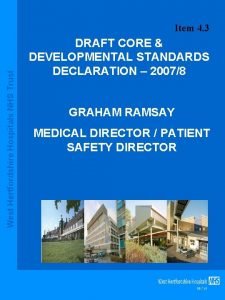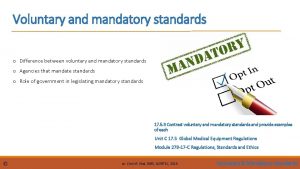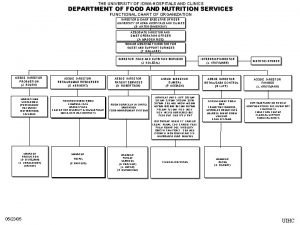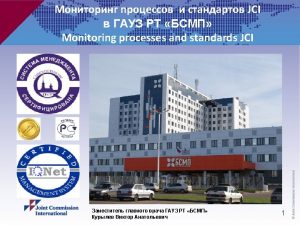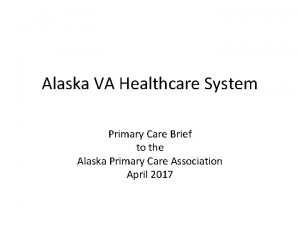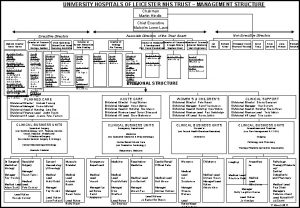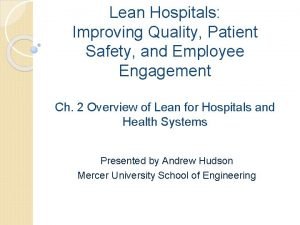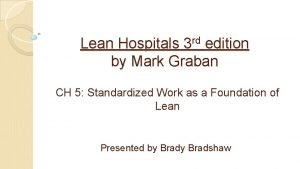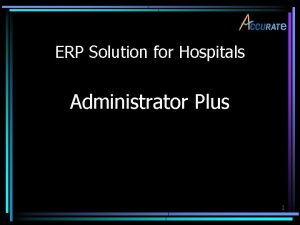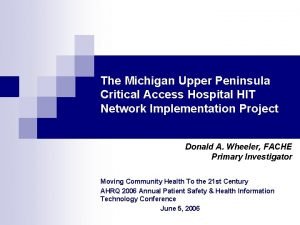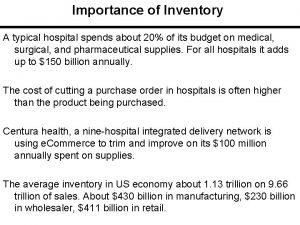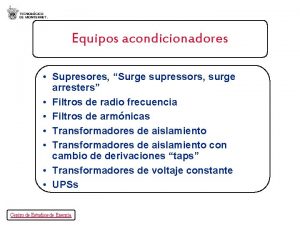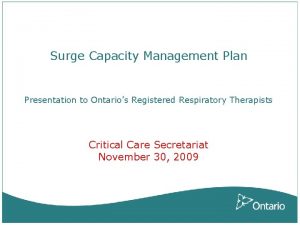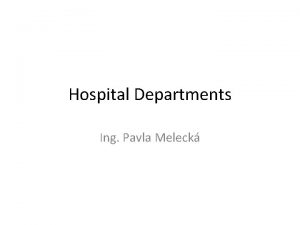Practical Solutions for Capacity Surge Management in Hospitals

































- Slides: 33

Practical Solutions for Capacity (Surge) Management in Hospitals The Second National Emergency Management Summit Washington DC February 3 rd 2008 Barbara Bisset, Ph. D MPH MS RN EMT Executive Director Emergency Services Institute Wake. Med Health & Hospitals

Presentation Objectives • To provide an awareness of tools for successful daily hospital capacity management – Capacity Management Criteria Matrix: Levels 1 -5 – Daily Management Report – Department Capacity Management Quick Response Guides – Hospital Expansion Space Matrix – Emergency Operations Assigned Spaces

Project Deliverables • Concept for use in hospital’s daily operations • Flexible template for use by North Carolina rural or urban hospitals • Template adaptable to existing hospital processes

Capacity Management Challenges

Considerations for Planning: Acute Events • Anticipate patients arriving within 15 minutes • Most casualties will NOT arrive by ambulance • Least serious casualties generally arrive first • Casualties disproportionately distributed between hospitals Auf der Heide, Eric, MD MPH Annuals of Emergency Medicine (2006, January) Volume 47, No I

Considerations for Planning • Most hospitals already operate at maximum or high level capacity • Multiple portals of entry for admission • Capacity issues may last for days, weeks or months • Most hospitals operate with staffing shortages on a regular basis

Definitions • Capacity Surge (Volumes of Patients) – Ability to evaluate and care for markedlyincreased volume of patients exceeding normal capacity – Surge requirements may extend beyond direct patient care • E. g. , laboratory studies, epidemiological investigations Hospital Incident Command System, Version IV (2006)

Definitions • Capability Surge (Types of Patients) – Ability to manage patients requiring unusual or very specialized medical evaluation and care – Expertise, information, procedures, equipment and personnel are normally not at the location where they are needed – Special intervention to protect medical providers, patients, and/or facility Hospital Incident Command System, Version IV (2006)

Definitions • Capability (Types of Patients) – Special populations • • • Diagnosis indicates need for cohorting, isolation, Acuity level requires critical care Compassionate / palliative care Burns Pediatrics Dialysis Contaminated patients Mental / social health Concerned, but well – Care requires specialized equipment, supplies, space, facility requirements, and/or knowledgeable, skilled staff

Scope of Capacity Plan • Management of patient capacity, capability surge emergency, or disaster event within hospitals • Does NOT include alternative care facilities or other state and/or community initiatives

Capacity Management Criteria Matrix Levels 1 -5 Homeland Security Advisory System (GRAY) LOW (Low Risk of Terrorist Attacks) (Green) GUARDED (General Risk of Terrorist Attacks) (Blue) ELEVATED (Significant Risk of Terrorist Attacks) (Yellow) HIGH (High Risk of Terrorist Attacks) (Orange) SEVERE (Severe Risk of Terrorist Attacks) (Red) (Lavender) Hospital Capacity Management System Capacity Alert Levels (Gray) LEVEL 0 LEVEL 1 LEVEL 2 LEVEL 3 (OPEN) (PRECAPACITY) (IMPAIRED) (GRIDLOCK) (Yellow) (Orange) (Green) (Blue) LEVEL 4 LEVEL 5 (DIVERSION/ ON HOLD) Local, Regional or State Declared Emergency /Disaster (Red) (Lavender) Resource for Capacity Levels 0 -4: Lehigh Valley Hospital & Health Network, Allentown Pennsylvania

Capacity Management Criteria Matrix Levels 1 -5 • Steps to Develop Criteria for Levels 1. Identify all portals of entry to hospital system 2. Identify criteria that are common predictors for successful “throughput”, such as: • • Vacancies Discharges vs. Admission Requests Internal Transfers Flow at Portals of Entry 3. Identify the criteria formula for each level (0 -5) for • Portals of Entry Departments • Each inpatient facility within the hospital system • Hospital System-wide

Capacity Management Criteria Matrix Levels 1 -5 Alert Level Vacancies DC’s vs. Admits Internal Transfers Flow at Portals of Entry Open Pre-Capacity Impaired Gridlock Diversion Declared Emergency

Capacity Management Criteria Matrix Levels 1 -5

Department Capacity Management Quick Response Guides All departments focus on capacity processes: • Every department develops action plan for response to each of the five levels • Level five includes department steps for responding to mass casualty events Capacity Alert Levels LEVEL 0 LEVEL 1 LEVEL 2 LEVEL 3 (OPEN) (PRE-CAPACITY) (IMPAIRED) (GRIDLOCK) LEVEL 4 LEVEL 5 (DIVERSION/ ON HOLD) Local, Regional or State Declared Emergency /Disaster

Department Capacity Management Quick Response Guides

Considerations for Determining Expansion Spaces Within Facility • Regulatory standards are applicable at all levels of capacity – Licensed versus unlicensed space – Division of Health Services Regulations FS must be notified before use of unlicensed space • Consider ways for immediate bed expansion (within 30 minutes) • Need to consider space requirements for capability population, e. g. pediatrics, burns

Considerations for Determining Expansion Spaces Within Facility Identification of Patient Care Expansion Spaces – Capacity Matrix – Capability Matrix – Identify actual space, number of potential beds, equipment, supplies and staffing needed – Estimated time needed for set up

Inpatient Capacity Expansion Matrix

Inpatient Capability Expansion Matrix

Emergency Department Expansion Matrix

Capacity Expansion Space Equipment and Supplies Assessment

Capacity Expansion Space Equipment and Supplies Assessment Equipment and Supplies – Just-in-time inventories vs. preparedness for 72+ hours – Specialty equipment for capability events – Mobility of equipment

Emergency Operations Support Space – Hospital Command Center – Crowd Management Center – Call Centers • Medical Advice • Hospital Public Emergency Information – Staging Centers for Transfer of Patients – Discharge Patient Lounges

Emergency Operations Support Space

Daily Capacity Management Report Send daily report to management More frequently reported at Level 3 -4 Recalculated when emergency event is declared Incorporate colors, criteria, action plan – – – Capacity Alert Levels Management page messages at 6 am Surgery Report Email messages to management Capacity Spreadsheet Physician Alert Screens LEVEL 0 LEVEL 1 LEVEL 2 LEVEL 3 LEVEL 4 LEVEL 5 (OPEN) (PRE-CAPACITY) (IMPAIRED) (GRIDLOCK) (DIVERSION/ ON HOLD) Local, Regional or State Declared Emergency

Daily Capacity Management Report

Daily Capacity Management Report

Daily Capacity Management Report

Evidence Based Evaluations • Evaluate events/drills – If in gridlock more than 24 hours • Department and Incident Command Work Sheets • Develop After Action Report (AAR) – Follow identified actions through completion – Incorporate into Environment of Care Emergency Management Program

Summary • Tools to identify and manage capacity and Capability challenges on a daily basis in normal operations or in emergency / disaster events – – – Capacity Management Criteria Matrix Daily Capacity Management Report Department Capacity Quick Response Guides Expansion Space Matrix Emergency Operations Assigned Spaces • Daily communications to key stakeholders

Recognition of Other Project Leaders Grant Funded Project BT 07 -1095 In Collaboration with North Carolina Emergency Medical Services & North Carolina Public Health Janice Frohman, MHA BSN RN Administrative Director Emergency Services Wake. Med Health & Hospitals Heidi Mc. Afee, MSN BSN RN Director Patient Access Wake. Med Health & Hospitals

Questions ? For further information, please contact Barbara Bisset, Ph. D Executive Director Emergency Services Institute bbisset@wakemed. org North Carolina Hospital Surge Plan Template BT Grant Contract # 02076 -07
 Surge capacity
Surge capacity Bed management in hospitals
Bed management in hospitals Specific heat capacity practical
Specific heat capacity practical Production units have an optimal rate of output where:
Production units have an optimal rate of output where: Practical packaging solutions
Practical packaging solutions Demand management and capacity management
Demand management and capacity management Difference between voluntary and mandatory
Difference between voluntary and mandatory University of iowa hospitals and clinics
University of iowa hospitals and clinics Portsmouth hospitals nhs trust values
Portsmouth hospitals nhs trust values Health standards section
Health standards section Jci accreditation standards for hospitals
Jci accreditation standards for hospitals Echs visakhapatnam
Echs visakhapatnam Application of computer in hospital
Application of computer in hospital Dnv niaho standards
Dnv niaho standards Bcp for hospitals
Bcp for hospitals Va hospital fairbanks alaska
Va hospital fairbanks alaska Mededcoventry
Mededcoventry Simon sheppard nhs birmingham
Simon sheppard nhs birmingham Strengths and weaknesses of hospitals
Strengths and weaknesses of hospitals Lean hospitals
Lean hospitals Graban lean hospitals download
Graban lean hospitals download Fhpl login
Fhpl login Erp for hospitals
Erp for hospitals Keshvendra kumar ias
Keshvendra kumar ias University hospitals
University hospitals Mghs wheelers
Mghs wheelers Portsmouth hospitals nhs trust jobs
Portsmouth hospitals nhs trust jobs National accreditation board for hospitals
National accreditation board for hospitals Lokmanya tilak hospital chinchwad
Lokmanya tilak hospital chinchwad 2 bin inventory hospitals
2 bin inventory hospitals Process governance
Process governance Capacity building solutions
Capacity building solutions Surge and rapid response team
Surge and rapid response team Surge current protection
Surge current protection

